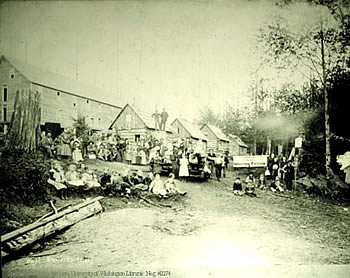
Lesson Eighteen:
The Industrial Workers of the World (I.W.W.) in Washington
The Equality Colony (left), located in Skagit County, was founded in 1897. The "B.C.C." seen in this group photograph stood for the Brotherhood of the Cooperative Commonwealth, which planned to convert Washington to socialism by creating a system of colonies throughout the state. (Special Collections, University of Washington, Social Issues Files Aa. neg. #2274 or #11282) Arthur A. Denny (below). (Special Collections, University of Washington, Portrait Files, neg. #6881.)
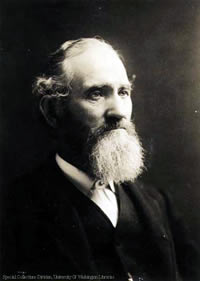
In the later 1880s Arthur A. Denny, one of the founders of Seattle, set down some impressions of what he called "pioneer days on Puget Sound." Ostensibly presenting a "factual" account of early settlement, Denny took numerous opportunities to contrast the ethos of "pioneers" like himself to the attitudes of modern workers who, Denny explained more than once, did not hold pioneers in very high regard. Consider the following example:
...we were all capitalists in those days. Each one expected to help himself, and as a rule all went to work with energy to open up the country and make homes for themselves....I will presume to say that if the people now possessed more of the spirit that then actuated the "old moss backs," as some reproachfully style the old settlers, we would hear less about a conflict between labor and capital, which in truth is largely a conflict between labor and laziness. We had no eight hour, nor even ten hour days then, and I never heard of any one striking, not even an Indian.... [From Denny, Pioneer Days On Puget Sound (Seattle: C. B. Bagley, Printer, 1888), 27. Keep in mind that Denny wrote this shortly after the anti-Chinese movement, spearheaded by organized labor, had crested in Seattle. Denny and others from Seattle's elite had opposed labor's actions.]
When Denny wrote, he looked back upon conditions that no longer existed for most newcomers to the Northwest. For example, the idea that a household could attain for free, as Denny had, a donation land claim of 160 acres (320 if one were married), in areas quite valuable for agriculture, commerce, or land speculation, was foreign to newcomers in the 1880s. There was no longer room for new arrivals on the ground floor of the city; there was little chance that all people could be "capitalists" any longer. Most recent migrants worried about having to accept a lifetime of working for wages, often for employers who showed little sensitivity to the welfare of labor. New conditions helped to create new attitudes toward capital and labor, ones that challenged sharply those held out by Arthur Denny.
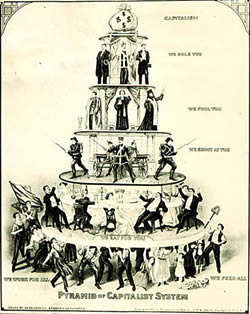
"Pyramid of Capitalist System," issued by Nedeljkovich, Brashich, and Kuharich in 1911. During the Depression and New Deal, labor unions demonstrated their solidarity by marching in Labor Day parades. (Special Collections, University of Washington, Social Issues Files Dc/vi. neg. #1535. Cleveland: International Publishing Co., 1911)
The Industrial Workers of the World, or I.W.W., epitomized the new outlook in its more radical guise. Founded in 1905, more than a decade before the Communist Party emerged as a factor in American radical life, the I.W.W. took Marxism and made it accessible to relatively uneducated workers. The union appealed especially to the highly mobile laborers who worked in such industries as logging, milling, mining, fishing, railroading, and farming. In a way, these workers stood as a kind of antithesis to the "stable," landowning, town-founding "pioneers" that Denny lionized. And Wobbly ideology was diametrically opposed to the laissez-faire views of Denny and other members of the economic elite. "It is the historic mission of the working class to do away with capitalism," the Wobblies argued. "By organizing industrially we are forming the structure of the new society within the shell of the old." Another I.W.W. maxim held that "the working class and the employing class have nothing in common." Whereas Denny had assumed that labor in the industrial age needed only to show the same work ethic and make the same sacrifices as the pioneers had displayed, Wobblies disputed the ideology of capitalism and proposed to overturn the entire system on which it rested. They never explained very clearly how that transformation was to occur, but they were convinced it was coming. And, along with other radicals and reformers, they acted as if the Pacific Northwest might be one of the first places to usher in the big change.
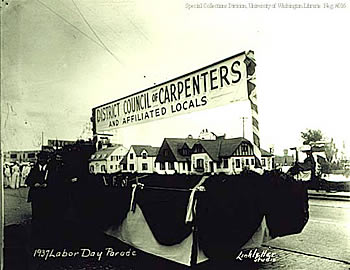
This 1937 view shows the District Council of Carpenters, below left. (Special Collections, University of Washington, Social Issues Files Dd/iv. neg. #016)
The rise and fall of the Wobblies in Washington state during the early 20th century can serve as a measure of how the urban and industrial Northwest differed from Denny's pioneer Northwest. The story of the I.W.W. also illuminates the fate of radicalism in the region. Socialism and unions appealed to many within the rapidly expanding population of the Pacific Northwest. To numerous laborers they seemed to be sensible responses to the nature of the new industrial order. Thus organizations such as the Industrial Workers of the World grew to have a substantial amount of influence in the region. Such organizations also caused a great deal of alarm among businessmen and the more conservative elements in society. One response to the challenge presented by radicalism was reform; progressives in particular sought ways to make industrial capitalism work more smoothly by removing the rough edges in the system that so antagonized workers. Another response, attempted simultaneously, was repression; by 1920 business and political leaders had succeeded in crippling the I.W.W. and other radical groups. Thus one can see in the years between 1885 and 1920 a cycle of emergent radicalism, and then severe reaction to radicalism, leading to the quite conservative politics of the 1920s. In the period 1930-1960 this pattern was repeated: radicalism emerged anew during the Great Depression (while reformers tried to address radicals' grievances in a more limited way), another Red Scare ensued in the late 1940s, and then a generally conservative political mood prevailed during the 1950s. These two cycles affected the entire Pacific Northwest to some degree, but the extremes of radicalism and reaction were particularly dramatic in the state of Washington. (See also: The Cold War and Red Scare in Washington State.)
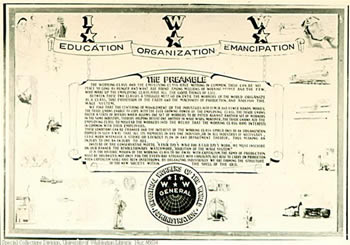
The Industrial Workers of the World was created in 1905 at a famous meeting in Chicago. The organization attracted some of the best and most energetic radical minds of the day, and they tried to provide a theoretical foundation for the union. But the radical thinkers quickly divided into factions, and there was little stability in Wobbly ideology. The I.W.W. attracted more than radical thinkers, however. It also appealed to a wide variety of laborers who had few or no other union voices eager to speak for them. The "guiding principle" of the I.W.W., explains Doug Honig, was "'industrial unionism,' the notion that all workers in a given industry [lumber or mining, for instance] should be organized in the same union. These groupings would some day join together in One Big Union of all workers, skilled and unskilled, men and women, black and white. The One Big Union would run society as a Cooperative Commonwealth, thereby ending the reign of greedy capitalists." [Doug Honig, "One Big Union," Landmarks: Magazine of Northwest history and preservation, IV:1-2, p. 69.] The Wobblies thus reached out to all workers, and attempted to organize groups who had largely been neglected by more established unions—unskilled workers, immigrants, women, and people of color. They especially recruited the largely male, family-less, migratory and seasonal workers—loggers, farm laborers, miners, and railroad workers—who had proven too difficult for more conventional unions to organize. Migratory and seasonal laborers provided the bulk of the I.W.W. membership in the Pacific Northwest and accounted for its considerable regional appeal and influence. They were also, however, notoriously difficult to discipline and coordinate, and this constituted one of the inherent weaknesses of the I.W.W.
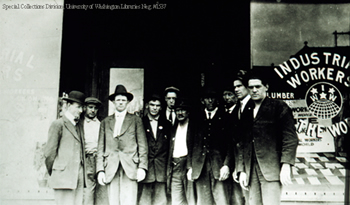
The Industrial Workers of the World served three purposes for Northwest labor. First, it functioned as a union, seeking better pay and working conditions through strikes and other actions. Second, it functioned as a "revolutionary cadre working to overthrow capitalism," as Honig explains. Third, the I.W.W. functioned as a meeting place and social experience. Its union halls, located in towns across the region, served as places where workers (most of whom had no family ties) could congregate with others, seek amusement and contact, and learn about job opportunities. These multiple purposes broadened the organization's appeal; they also probably brought together people who did not always have the same agendas. Partly by design and partly by circumstance, the I.W.W. was a diverse and rather unwieldy organization. As a result, its methods were often as unorthodox as its politics.
This I.W.W. hall (right) might be Seattle's headquarters on 2d Ave. (Special Collections, University of Washington, Social Issues Files Dc/i. neg. #1537)
The Wobblies "free-speech fight" in Spokane during 1909 illustrated the organization's unusual approach. The struggle began in response to the existence of corrupt employment agencies, many of which were located along Stevens Street in Spokane. These agencies recruited workers for jobs in logging, milling, mining, farming, and construction throughout the Inland Empire. They generally charged a dollar for their services. Too often, however, workers would find that the job they had been promised did not exist, or else they might be fired after one day of work and have to go back to Spokane and pay another dollar to learn about another job. Late in 1908 the I.W.W. decided to protest these conditions; Wobblies began demonstrating along Stevens Street to complain about the agencies, encourage a boycott of them, and spread the One Big Union's message. The city of Spokane reacted by passing a law prohibiting street meetings and public rallies. The Wobblies obeyed this ordinance until it was amended in summer 1909 to permit the Salvation Army to preach and hold meetings in the street. Because Wobblies regarded the Salvation Army as their fiercest rival for the souls of down-and-out workers, they responded by openly violating the city ordinance. It was crucial to Wobblies that they uphold their right to organize and recruit workers in the streets; the organization could not rely on conventional means of recruitment, and also wanted to disseminate its ideas as widely as possible. Defending their right to "free speech," the Wobblies decided to break the city law and, by getting themselves arrested and imprisoned, become a financial and public-relations burden on Spokane's municipal government. I.W.W. newspapers successfully summoned other Wobblies from around the region to join the fight, using headlines like, "Wanted—Men to Fill the Jails of Spokane."
Remarkably, the free speech fight worked. Spokane, of course, did not welcome the I.W.W. Many of the arrested Wobblies were mistreated in jail, where three died, but this brought only more condemnation of the city by liberal and moderate citizens, and more exposes in local newspapers. Having spent $250,000 to convict and jail Wobblies, and facing another $100,000 in legal claims from Wobbly plaintiffs, the city finally gave in to the union after five months. It released Wobbly prisoners from jail, permitted limited public speaking in the streets, and along with the state legislature began to regulate more carefully the practices of employment agencies. The business licenses of 19 employment agents were revoked. Most importantly for the union, the I.W.W. attained considerable acclaim for its unusual and successful action.
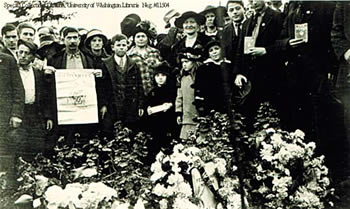
Felix Baran Funeral, 1916 (left). I.W.W. members staged elaborate funerals for the victims of the Everett Massacre. This photograph shows the funeral of Felix Baran in November 1916. (Special Collections, University of Washington, Social Issues Files Dc/i. neg. #11504.)
Over time the enemies of the One Big Union became more effective in opposing it, partly because repressive policies often worked and partly because conditions changed so that the I.W.W. received less support than before. The events of 1916-1920 brought about the organization's downfall in Washington. In 1916 Wobblies from Seattle attempted to organize another free-speech fight in Everett, where they hoped to come to the assistance of striking shingle weavers. (Shingle weavers worked in sawmills that manufactured shingles for roofs. Their job included steering blocks of wood through saws that shaped the lumber into shingles. It was often said that shingle weavers recognized one another by the digits missing on their hands.) Capitalists and managers in Everett, already defeating the shingle weavers, were determined not to let the I.W.W. revive the strike or radicalize further the Everett citizenry. They deployed the local police to beat and torture the Wobblies who came to Everett. The Wobblies refused to back down, however, and on November 5, 1916 a boatload of armed Wobblies steamed from Seattle to Everett. They were met by an armed delegation of deputies and hired guns at the Everett dock. Shots rang out—who fired first was earnestly disputed—and after the shooting was over there were casualties all around: perhaps a dozen Wobblies killed and another thirty wounded, as opposed to two Everett deputies killed and as many as twenty wounded. Seventy-four passengers from the boat were arrested on charges of murder upon their to Seattle; after one man was acquitted the others were released. None of the Everett gunmen were arrested or tried.
Everett's civic and business leaders proved more conservative and repressive than most. [See Norman H. Clark, Mill Town: A Social History of Everett, Washington... (Seattle: University of Washington Press, 1970).] But their harsh treatment of the I.W.W. foreshadowed the events of 1917-1920. The entry of the United States into World War One, and the nationwide alarm that greeted the Bolshevik success in Russia, made Americans even less tolerant of Wobblies. That the I.W.W. opposed the war and American involvement in it only made matters worse, for Wobblies came to be seen as unpatriotic and worse. The organization helped to spearhead a large-scale strike in the lumber industry during the spring and summer of 1917; one of their goals was an 8-hour day. (Working conditions in the forests were so bad that more moderate unions had also decided to strike.) Timber companies resisted the idea of an 8-hour day, but they disliked even more the thought of giving in to I.W.W. pressure. The Wobblies called off the strike and went back to work, but they "transferred the strike to the job," in Honig's words. That is, they undermined production by wasting time and slowing down their work in myriad ways. All this came, of course, at a time when the demand for timber had reached new heights, and when timber was regarded as an essential resource for the war and particularly for building military planes. The Wobblies' striking and shirking on the job, then, was all too easily perceived as injuring the U.S. war effort and endangering American soldiers.
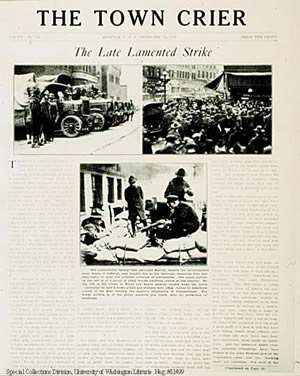
In the end, the War Department intervened in Pacific Northwest forests to end labor tensions and ensure increases in production. It put soldiers to work at logging; created a company union for all timber workers (the Loyal Legion of Loggers and Lumbermen, or 4-L) that supplanted the I.W.W.; and imposed improvements on the industry, such as an 8-hour day and better living conditions in lumber camps, that addressed workers' sorest complaints. Workers no longer needed the I.W.W., even though the industry adopted many of the changes it had supported. Moreover, the union's wartime actions were now seized upon to discredit the organization, both around the Northwest and nationally. The federal government began deporting recent immigrants who were Wobbly members, and the Washington state legislature passed "criminal syndicalism" legislation that outlawed "the mere advocacy of political change through intimidation or sabotage," as Honig explains. By 1919, the U.S. government had launched a full-fledged and largely successful campaign to destroy the I.W.W. and other radical organizations.
Back in Washington, the townspeople of Centralia struck a severe blow against the Wobblies in 1919. During an Armistice Day parade, American Legionnaires rushed the I.W.W. union hall to attack the hated Wobblies inside and run them out of town. Partly because Wobblies had been similarly attacked two years before, they stood armed and ready this time, inside the hall as well as at points across the street, opened fire on the Legionnaires, and killed six. The Wobblies were then arrested. That night, one of them was abducted from the city jail, hanged from a nearby bridge, and mutilated. Centralia's vigilantes were never caught or tried; the surviving Wobblies who had shot at the Legionnaires, on the other hand, were tried, convicted, and imprisoned, much to the approval of public opinion, which complained only that their punishments were not harsh enough. [On the so-called "Centralia Massacre," see John McClelland, Jr., Wobbly War: The Centralia Story (Tacoma: Washington State Historical Society, 1987).]
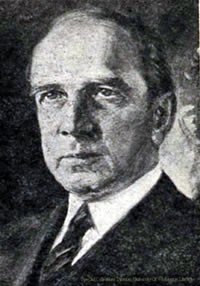 The same year as the Centralia Massacre, Seattle experienced a general strike. On Feb. 15, 1919, following its failure, The Town Crier reported on "The Late Lamented Strike," (above). (Special Collections, University of Washington, Social Issues Files Dc/iii. neg. #11499). Roland Hartley, governor of Washington, 1925–1933, (left). (Reproduced in Louis A. Magrine, Meet the Governors of the State of Washington. Seattle and Tacoma, 1946. p.55.)
The same year as the Centralia Massacre, Seattle experienced a general strike. On Feb. 15, 1919, following its failure, The Town Crier reported on "The Late Lamented Strike," (above). (Special Collections, University of Washington, Social Issues Files Dc/iii. neg. #11499). Roland Hartley, governor of Washington, 1925–1933, (left). (Reproduced in Louis A. Magrine, Meet the Governors of the State of Washington. Seattle and Tacoma, 1946. p.55.)
The end result of the violence in Centralia did not by itself seal the fate of the I.W.W. in Washington, but it came at a time when the Wobblies were already in retreat. Union radicalism had been rejected by the vast majority of Americans, especially during and after World War One. Indeed, the war brought an end to most of the reform activity that had characterized the progressive era, and it reduced people's tolerance for radicalism. The I.W.W. and other socialist and reform groups did not disappear overnight; many lingered on until the desperately hard times of the 1930s gave them new life—albeit often under different names. (Between the 1930s and the 1950s in Washington, the Communist Party would play something like the role that the I.W.W. played between 1905 and 1920.) But the decade after 1919 was characterized by conservatism, nor progressivism or radicalism or populism. It was typical of the time that Roland Hartley, one of the quite conservative industrialists who had ruled Everett at the time of the 1916 shingle weavers' strike, became governor of the state from 1925 to 1933. As Norman Clark explains:
There was little about progress and nothing about the Progressive Age which [Hartley] could not hold up to wrath and condemnation. He detested prohibitionists, social workers, suffragettes, direct primaries, and direct legislation. He hated radicals, agitators, internationalists, pacifists, unions, taxes, and progressive education. He was proud that as a legislator he had introduced laws against picketing and against the teaching of social science. He had voted against an eight-hour law for women (Mill Town, p. 164).
Governor for a post-reform and post-radical age, Roland Hartley was the kind of leader with whom Arthur A. Denny might have felt comfortable.
| Course Home | Previous Lesson | Next Lesson |